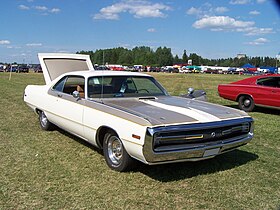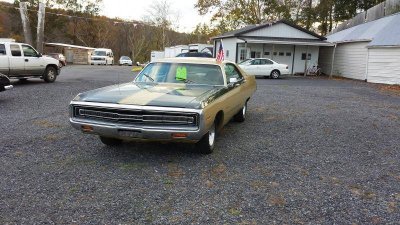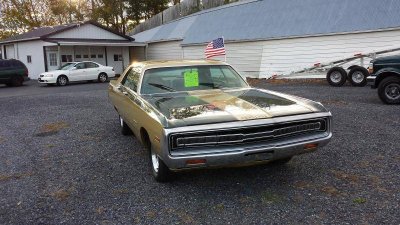This may help,
The only Hurst edition Chrysler ever made was in 1970.
1970 Hurst 300
[TABLE="class: infobox hproduct, width: 22"]
[TR]
[TH="class: fn, bgcolor: #C0C0C0, colspan: 2, align: center"]Hurst 300[/TH]
[/TR]
[TR]
[TD="colspan: 2, align: center"]

[/TD]
[/TR]
[TR]
[TH="bgcolor: #C0C0C0, colspan: 2, align: center"]Overview[/TH]
[/TR]
[TR]
[TH="align: left"]Production[/TH]
[TD]
[/TD]
[/TR]
[TR]
[TH="bgcolor: #C0C0C0, colspan: 2, align: center"]Body and chassis[/TH]
[/TR]
[TR]
[TH="align: left"]
Body style[/TH]
[TD]
[/TD]
[/TR]
[TR]
[TH="bgcolor: #C0C0C0, colspan: 2, align: center"]Powertrain[/TH]
[/TR]
[TR]
[TH="align: left"]
Engine[/TH]
[TD]440 cu in (7.2 L)
TNT V8[/TD]
[/TR]
[TR]
[TH="align: left"]
Transmission[/TH]
[TD]3-speed Torqueflite
A727 automatic[/TD]
[/TR]
[/TABLE]
See also:
Chrysler 300 non-letter series § 1969–1971
The 1970
Hurst 300 lacks the single-letter suffix of its forbears and appeared five years after the last Letter Series Chrysler, the 300L. Many automobile historians do not include the Hurst 300 as a Letter Series model. The concept of the car, however, does fit with the Letter Series cars, as it was a high-performance variant of the luxury 300, built with the input of aftermarket parts manufacturer
Hurst Performance. Only 501 units are believed to have been built.
The Hurst 300s were all 2-door and shared a white and gold paint scheme similar to the
Oldsmobile and
Pontiac Hurst models of the day. The scooped hood and trunklid (with a molded spoiler) are both fiberglass. All Hurst 300s had satin tan leather interiors that were straight out of the
Imperial and could be had with column- or console-mounted 727 automatics. All came with the 375 hp (280 kW) 440 cu in (7.2 L) 4-barrel
TNT V8 engine. Road tests clocked one at 0–60 at 7.1 seconds with the [SUP]1[/SUP]⁄[SUB]4[/SUB] mile in 15.9 seconds. "Not bad for a 4,100 lb (1,900 kg)
aircraft carrier", they claimed.
Of the 501 units sold, one convertible is documented having been used as a Hurst promotional car and another is believed to have been dealer equipped with a 426 cu in (7.0 L) Hemi, also, a convertible.
Boardroom Muscle – 1970 Chrysler 300 “Hurst Edition”
By
Forward Look | March 1st, 2012 1:47 PM

When it burst on the scene in 1955, the Chrysler 300C redefined American power. Chrysler produced a new, limited “letter series” 300 every year until the 300L in 1965 – the year that Chrysler halted production of the venerable beast. However, just four years later, the 300 returned in an unusual way.
The 1970 Chrysler 300 “Hurst Edition” (unofficially known as the Chrysler 300 H) was a collaboration between Chrysler and Hurst Performance. Measuring at a whopping 18-feet long, the 300 Hurst is one of the largest coupes ever made. But don’t let its size fool you – in true Chrysler 300 fashion, it cranked out 375 horsepower thanks to its big-block 440 V-8 engine.
The 300 Hurst was assembled at Chrysler’s Jefferson Avenue plant in Detroit. In Warminister, PA, Hurst outfitted the car with a “Satin Tan” painted fiberglass hood and trunk lid with a spoiler. Orange and brown decal stripes adorned the fiberglass edges and “300 H” emblems were painted on the sides of the power bulge on the hood scoop.
Neither Chrysler nor Hurst ever promoted the vehicle and the production run of less than 500 were scattered around Chrysler dealerships. Today, the debate rages on about the exact number of vehicles produced and whether the “Hurst Edition” is a rightful heir to its 300 letter-series predecessors. What is certain, though, is that a huge body, ferocious engine, and limited production make it a certified classic.
























